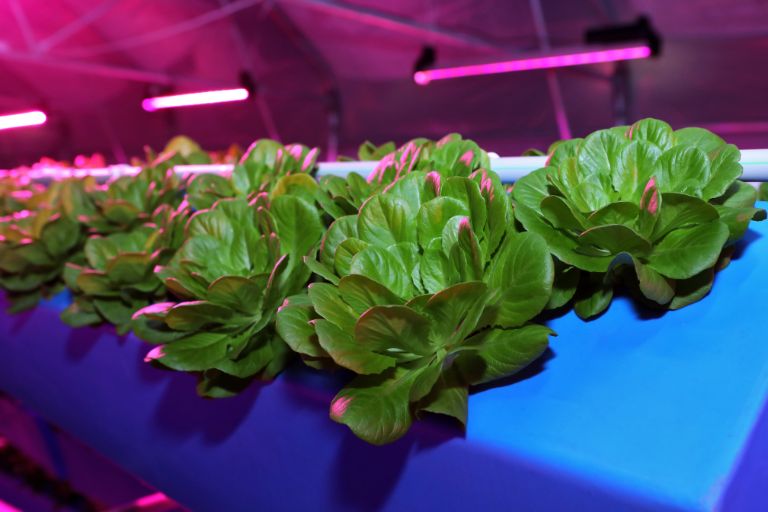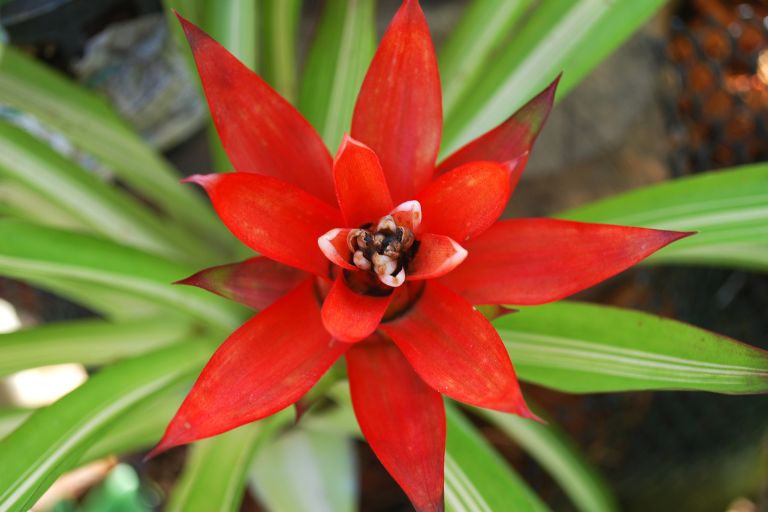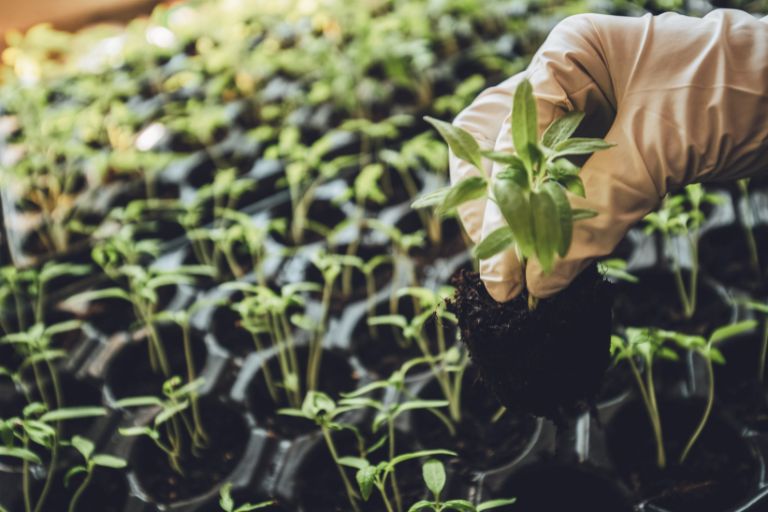Breathing Easy: Harnessing the Power of Air Purifying Plants for Indoor Spaces
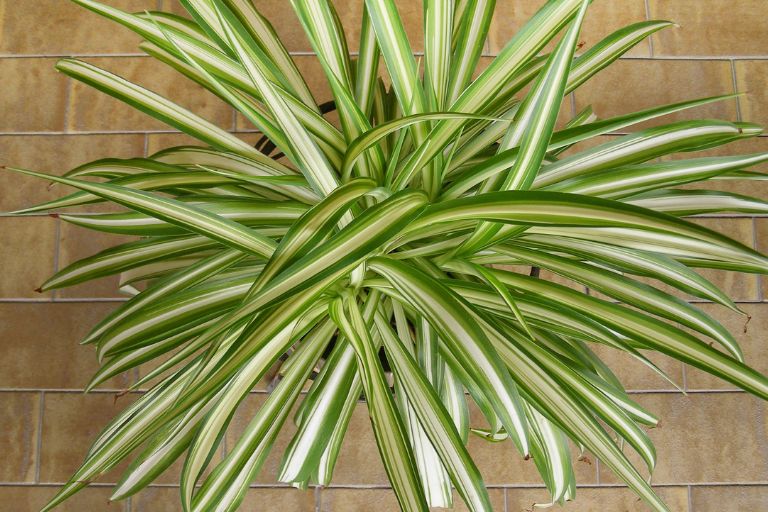
In our increasingly indoor-centric existence, where a significant proportion of our time is spent in enclosed spaces, the quality of the air we breathe is of paramount importance to our overall health and well-being. Indoor air pollution is a major challenge, with a wide range of pollutants such as volatile organic compounds (VOCs), allergens and airborne toxins permeating our homes, workplaces and other indoor environments. Fortunately, in the midst of these concerns, nature offers a powerful remedy: air purifying plants.
In recent years, there has been a surge in awareness of the ability of plants to purify the air we breathe. Beyond their aesthetic appeal, certain plant species have a remarkable ability to filter out harmful pollutants, effectively transforming indoor environments into healthier havens. Understanding the science behind these botanical air purifiers and harnessing their potential is crucial to creating indoor spaces that not only support physical health, but also promote mental clarity and vitality.
In this article, we embark on an exploration of air-purifying plants, delving into their fascinating mechanisms for improving indoor air quality and their practical applications in our daily lives. From elucidating the science behind plant-mediated air purification to identifying the most effective species for indoor use, we delve into the essential knowledge and practical insights needed to cultivate cleaner, fresher air in our indoor sanctuaries. Join us as we unlock the secrets of these green guardians and pave the way for a healthier indoor environment.
The Science Behind Air Purifying Plants
Plants have a remarkable natural ability to filter the air through two key processes: photosynthesis and transpiration.
Photosynthesis
– Photosynthesis is the process by which plants use sunlight, carbon dioxide (CO2) and water to produce oxygen (O2) and carbohydrates, such as sugars and starches.
– During photosynthesis, plants absorb carbon dioxide from the air through tiny openings called stomata on their leaves. The carbon dioxide is then converted into oxygen by chemical reactions in the chloroplasts of plant cells.
– This production of oxygen during photosynthesis helps to increase the amount of oxygen in the air, improving air quality and making it more suitable for human and animal respiration.
– While photosynthesis occurs mainly during the day when sunlight is available, some plants, such as certain succulents and orchids, use a type of photosynthesis called CAM (Crassulacean Acid Metabolism), which allows them to absorb carbon dioxide and release oxygen at night.
Transpiration
– Transpiration is the process by which plants release water vapour from their leaves into the surrounding air.
– Water absorbed by the plant’s roots moves upwards through the plant’s vascular system and eventually exits through tiny pores called stomata on the underside of the leaves.
– As water vapour is released into the air through transpiration, a gentle, natural air circulation is created around the plant. This air movement helps to disperse pollutants and particulate matter, reducing their concentration in the immediate vicinity of the plant.
– In addition, transpiration increases the humidity of the surrounding air, which can be beneficial in maintaining optimal indoor humidity levels, especially in dry environments.
Certain plant species have been shown to absorb and neutralise common indoor air pollutants through a process known as phytoremediation. This process involves the uptake, transformation or degradation of pollutants by plants, effectively removing or rendering them harmless. Below you’ll find information on how different plant species can target and neutralise specific indoor air pollutants:
Volatile organic compounds (VOCs)
– Certain plant species have the ability to absorb VOCs such as formaldehyde, benzene and toluene, which are commonly found in indoor environments due to household products, furnishings and building materials.
– Plants such as Peace Lily (Spathiphyllum spp.), Spider Plant (Chlorophytum comosum) and Boston Fern (Nephrolepis exaltata) have been shown to effectively absorb and metabolise formaldehyde, one of the most common indoor pollutants.
– Snake plant (Sansevieria trifasciata) and golden pothos (Epipremnum aureum) are known for their ability to remove benzene and toluene from indoor air, contributing to improved air quality.
Particulate matter
– Plants with large, dense foliage can effectively capture and remove particulate matter from the air, including dust, pollen and other airborne particles.
– Species such as the areca palm (Dypsis lutescens), rubber plant (Ficus elastica) and dracaena varieties (Dracaena spp.) have broad leaves that can trap dust particles and other airborne debris, helping to purify the air and reduce indoor air pollution.
Carbon monoxide (CO) and carbon dioxide (CO2)
– While plants generally absorb carbon dioxide during photosynthesis, some species have been shown to also absorb small amounts of carbon monoxide.
– Plants such as peace lilies (Spathiphyllum spp.) and gerbera daisies (Gerbera jamesonii) have been found to be effective in removing low levels of carbon monoxide from indoor air.
– In addition, increasing the density of indoor plants can indirectly reduce carbon dioxide levels by increasing the rate of photosynthesis, which consumes CO2 and releases oxygen.
Mould and mildew
– Certain plant species release compounds that inhibit the growth of mould and mildew, helping to prevent microbial contamination and maintain indoor air quality.
– Plants with antimicrobial properties such as English ivy (Hedera helix), aloe vera (Aloe barbadensis) and lavender (Lavandula spp.) can help reduce the growth of mould and mildew when grown indoors.
Research studies have provided compelling evidence of the effectiveness of air-purifying plants in improving indoor air quality. Below are some key findings from notable studies:
NASA Clean Air Study (1989)
– One of the most influential studies on the subject, the NASA Clean Air Study identified several houseplants capable of removing indoor air pollutants.
– The study found that certain plant species, including peace lily (Spathiphyllum spp.), spider plant (Chlorophytum comosum) and Boston fern (Nephrolepis exaltata), were effective at removing volatile organic compounds (VOCs) such as formaldehyde, benzene and trichloroethylene from indoor air.
– These results demonstrated the potential of air-purifying plants to improve indoor air quality and reduce concentrations of harmful pollutants.
Foliage plants for removing indoor air pollutants in energy-efficient homes (2009)
– This study, conducted by researchers at Pennsylvania State University, investigated the effectiveness of houseplants in removing volatile organic compounds (VOCs) from indoor air in energy-efficient homes.
– The study found that certain plant species, including Peace Lily (Spathiphyllum spp.), Golden Pothos (Epipremnum aureum) and Snake Plant (Sansevieria trifasciata), significantly reduced indoor VOC concentrations over a 24-hour period.
– These results provide further support for the use of air-purifying plants as a natural and cost-effective means of improving indoor air quality.
Phytoremediation of indoor air by potted plants (2010)
– This study, published in the Journal of the American Society for Horticultural Science, investigated the ability of potted plants to remove indoor air pollutants, including benzene, toluene and formaldehyde.
– The researchers found that several common houseplants, such as gerbera daisy (Gerbera jamesonii), snake plant (Sansevieria trifasciata) and chrysanthemum (Chrysanthemum morifolium), were effective in reducing indoor air concentrations of benzene, toluene and formaldehyde.
– These results highlighted the potential of air-purifying plants to act as natural air filters, improving indoor air quality and promoting healthier indoor environments.
Phytoremediation: A sustainable solution to air pollution (2020)
– This comprehensive review article, published in the International Journal of Environmental Research and Public Health, examined the role of phytoremediation in mitigating air pollution.
– The review summarised findings from various studies demonstrating the ability of plants to remove indoor air pollutants, including VOCs, particulate matter and microbial contaminants.
– The authors concluded that phytoremediation, particularly through the use of air-purifying plants, is a sustainable and environmentally friendly approach to improving indoor air quality and reducing the health risks associated with indoor air pollution.
Top Air Purifying Plants for Indoor Spaces
Below is a curated list of popular air purifying plants, along with their common names, scientific names and unique characteristics:
Peace Lily
Common name – French Lily
Scientific name – Spathiphyllum spp.
Unique features – Known for its elegant white flowers and shiny dark green leaves. Effective at removing airborne toxins such as formaldehyde, benzene and trichloroethylene.
Spider Plant
Common Name – Spider plant
Scientific name – Chlorophytum comosum
Unique features – Characterised by long, arching leaves with white striped margins. Produces small white flowers and baby spider plants (offsets). Excellent at removing formaldehyde and other indoor air pollutants.
Snake Plant
Common Name – Snake plant, Mother-in-law’s tongue
Scientific name – Sansevieria trifasciata
Unique features – Has stiff, upright leaves with distinctive patterns. Tolerant of low light and neglect, making it ideal for beginners. Removes toxins such as formaldehyde, benzene and xylene from indoor air.
Golden Pothos
Common Name – Golden Pothos, Devil’s Ivy
Scientific name – Epipremnum aureum
Unique features – Has heart-shaped leaves with variegated patterns of green and yellow. Grows vigorously and thrives in a variety of light conditions. Known for its ability to filter formaldehyde, benzene and xylene from indoor air.
Boston fern
Common name – Boston fern
Scientific name – Nephrolepis exaltata
Unique features – Has lush, feathery fronds that cascade gracefully. Prefers high humidity and indirect light. Effective at removing air pollutants and adding moisture to indoor air.
Areca Palm
Common name – Areca Palm, Butterfly Palm
Scientific name – Dypsis lutescens
Unique features – Known for its graceful, arching fronds and slender, bamboo-like trunks. Thrives in bright, indirect light and humid conditions. Filters out indoor air pollutants such as formaldehyde, benzene and xylene.
Rubber plant
Common name – Gum plant
Scientific name – Ficus elastica
Unique features – Has large, shiny leaves with a dark green or burgundy colour. Tolerant of low light and neglect. Effectively removes formaldehyde from indoor air and adds a touch of tropical elegance to interiors.
Aloe Vera
Common name – Aloe Vera
Scientific name – Aloe barbadensis
Unique features – Succulent plant with fleshy, spiny leaves containing a gel-like substance with medicinal properties. Needs bright, indirect light and well-drained soil. Known for its air purifying properties and ability to remove formaldehyde and benzene from indoor air.
These popular air purifying plants not only improve indoor air quality by filtering out harmful pollutants, but also add beauty and greenery to indoor spaces. Consider adding these plants to your home or office to create a healthier and more aesthetically pleasing environment.
The following is a breakdown of the specific pollutants that each of these air purifiers is known to be able to remove from the air:
Peace lily (Spathiphyllum spp.)
Removes: Formaldehyde, benzene, trichloroethylene, ammonia, xylene.
Spider plant (Chlorophytum comosum)
Removes: Formaldehyde, xylene, carbon monoxide, nitrogen oxides, benzene.
Snake Plant (Sansevieria trifasciata)
Removes: Formaldehyde, benzene, trichloroethylene, xylene, toluene.
Golden Pothos (Epipremnum aureum)
Removes: Formaldehyde, benzene, xylene, toluene, carbon monoxide.
Boston fern (Nephrolepis exaltata)
Removes: Formaldehyde, xylene, toluene.
Areca Palm (Dypsis lutescens)
Removes: Formaldehyde, benzene, xylene, toluene, carbon dioxide.
Rubber plant (Ficus elastica)
Removes: Formaldehyde, xylene, toluene, carbon monoxide.
Aloe Vera (Aloe barbadensis)
Removes: Formaldehyde, benzene, xylene, toluene.
These plants have been extensively studied for their ability to absorb and neutralise various indoor air pollutants, helping to improve indoor air quality and create healthier living environments.
Below you’ll find a comprehensive guide with care tips and ideal growing conditions for each air purifying plant mentioned:
Peace lily (Spathiphyllum spp.)
Light – Thrives in bright, indirect light but can tolerate low light.
Watering – Keep soil evenly moist but not soggy. Water when top inch of soil feels dry.
Humidity – Prefers high humidity. Regularly mist the leaves or place the pot on a humidifier tray.
Temperature – Ideal temperature range is 18-27°C (65-80°F).
Care Tips – Remove spent flowers to encourage continuous flowering. Feed monthly during the growing season.
Spider Plant (Chlorophytum comosum)
Light – Prefers bright indirect light but can tolerate low light.
Watering – Allow soil to partially dry between waterings. Water thoroughly and remove excess water.
Humidity – Adaptable to a range of humidity levels.
Temperature – Thrives in temperatures between 60-75°F (15-24°C).
Care Tips – Regularly pinch off brown or yellow leaves. Propagate baby spider plants by offset planting.
Snake Plant (Sansevieria trifasciata)
Light – Thrives in indirect light but can tolerate low light.
Watering – Allow soil to dry out between waterings. Water sparingly to avoid root rot.
Humidity – Adaptable to low humidity conditions.
Temperature – Prefers temperatures between 60-85°F (15-29°C).
Care Tips – Avoid overwatering as snake plants are susceptible to root rot. Wipe leaves with a damp cloth to remove dust.
Golden Pothos (Epipremnum aureum)
Light – Thrives in bright, indirect light but can tolerate low light.
Watering – Allow soil to partially dry between waterings. Water thoroughly and drain off excess water.
Humidity – Adaptable to a range of humidity levels.
Temperature – Prefers temperatures between 18-29°C (65-85°F).
Care Tips – Prune long vines to encourage bushier growth. Propagate by rooting stem cuttings in water.
Boston fern (Nephrolepis exaltata)
Light – Thrives in bright, indirect light but can tolerate some direct sunlight.
Watering – Keep soil evenly moist but not soggy. Mist foliage regularly to maintain moisture.
Humidity – Requires high humidity. Mist the foliage regularly or place the pot on a humidifier tray.
Temperature – Prefers temperatures between 65-75°F (18-24°C).
Care Tips – Regularly pinch back dead foliage. Feed with a balanced liquid fertilizer every 1-2 months during the growing season.
Areca Palm (Dypsis lutescens)
Light – Thrives in bright, indirect light but can tolerate some direct sun.
Watering – Keep soil evenly moist throughout growing season. Allow the top inch of soil to dry out between waterings in winter.
Humidity – Prefers high humidity. Regularly mist the leaves or place the pot on a humidifier tray.
Temperature – Prefers temperatures between 65-75°F (18-24°C).
Care Tips – Remove brown or yellowed fronds regularly. Topdressing every 2-3 months during the growing season.
Rubber plant (Ficus elastica)
Light – Thrives in bright, indirect light but can tolerate some direct sunlight.
Watering – Allow soil to partially dry between waterings. Water thoroughly and remove excess water.
Humidity – Adaptable to a range of humidity levels.
Temperature – Prefers temperatures between 60-75°F (15-24°C).
Care tips – Wipe leaves with a damp cloth to remove dust. Prune to maintain desired shape and size.
Aloe Vera (Aloe barbadensis)
Light – Prefers bright indirect light but can tolerate some direct sunlight.
Watering – Allow soil to dry out completely between waterings. Water sparingly, especially in winter.
Humidity – Adaptable to low humidity conditions.
Temperature – Prefers temperatures between 60-80°F (15-27°C).
Care tips – Plant in well-drained soil to prevent root rot. Harvest aloe gel as needed for medicinal purposes.
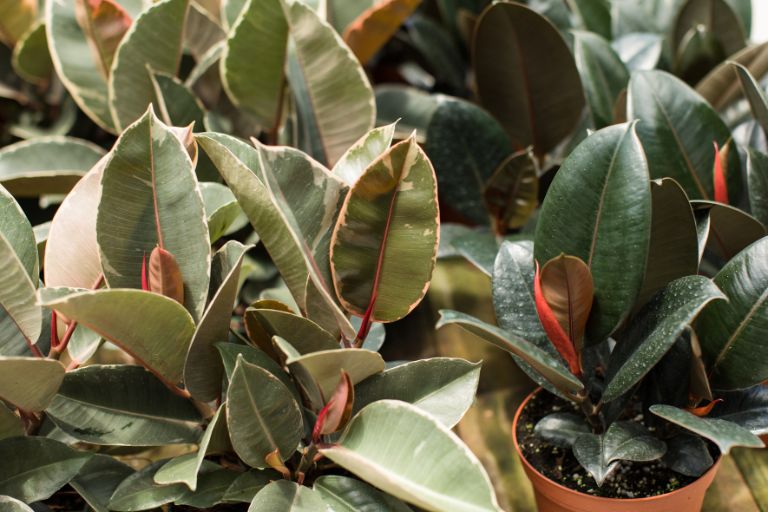
Integrating Air Purifying Plants into Indoor Environments
Selecting and arranging air-purifying plants in different indoor environments requires careful consideration of factors such as available light, space constraints and aesthetic preferences. Below are some practical tips for selecting and arranging air-purifying plants in different indoor environments:
Assess lighting conditions
– Consider the amount of natural light available in the room. Different plants have different light requirements, so choose species that will thrive in the light conditions available.
– For low-light areas, choose plants such as Snake Plant, Peace Lily and ZZ Plant that tolerate low light conditions. For bright, well-lit areas, consider plants such as Spider Plant, Rubber Plant and Areca Palm.
Consider space constraints
– Evaluate the space available for plant placement, taking into account factors such as floor space, table tops, shelving and hanging options.
– Choose compact or trailing plants such as Spider Plant, Golden Pothos and String of Pearls for smaller spaces. Use hanging baskets or wall-mounted planters to maximise vertical space.
Group plants for impact
– Create visually appealing displays by grouping plants based on size, shape and colour.
– Mix and match different types of plants to add interest and texture to indoor spaces. Combine tall, upright plants like Dracaena with trailing plants like Devil’s Ivy for a dynamic arrangement.
Consider airflow and traffic patterns
– Place plants strategically to allow adequate airflow around each plant. Avoid overcrowding plants as this can reduce air circulation and encourage pest infestations and disease.
– Position plants away from doorways, vents and high traffic areas to minimise disturbance and ensure plants receive consistent care.
Incorporate plants into interior design
– Use air-purifying plants as decorative accents to enhance the aesthetic appeal of indoor spaces. Choose planters that complement the decor and style of the room.
– Incorporate plants into existing furniture arrangements or create special plant display areas to showcase their beauty and benefits.
Consider maintenance requirements
– Select plants that match the level of care and maintenance you can provide. Choose low-maintenance options for high-traffic environments such as offices and schools.
– Establish a regular watering and maintenance routine to keep plants healthy and vibrant. Consider using self-watering planters or moisture meters to maintain optimal soil moisture levels.
Educate and engage occupants
– Educate occupants about the benefits of air-purifying plants and encourage them to participate in their care.
– Incorporate plants into educational programmes or wellness initiatives in schools and offices to promote environmental awareness and well-being.
Incorporating plants into interior design, while maximising their air purifying benefits, offers numerous creative opportunities to enhance both the aesthetic appeal and environmental quality of indoor spaces. Below are some creative ideas on how to achieve this:
Living Walls
– Create stunning living walls or vertical gardens using a variety of air-purifying plants. Install modular planting systems or vertical planters on interior walls to maximise vertical space.
– Choose a mix of trailing plants, such as Golden Pothos and String of Pearls, and upright plants, such as Dracaena and Peace Lily, to create visual interest and maximise air purification.
Room dividers
– Use large, potted plants strategically placed as partitions or screens to separate different areas within a room. Plants such as areca palm, rubber plant and bamboo palm are ideal for creating natural partitions while purifying the air.
– Incorporate tall, bushy plants such as Fiddle Leaf Fig and Bird of Paradise to create privacy screens or focal points in open spaces.
Hanging gardens
– Install ceiling planters or macramé hangers to create hanging gardens in rooms with limited space. Hang cascading plants such as spider plant, devil’s ivy and string of hearts to add vertical greenery and improve air quality.
– Hang plants near windows to take advantage of natural light and promote healthy growth while improving indoor air circulation.
Terrariums and miniature gardens
– Create miniature indoor gardens or terrariums with air purifying plants such as snake plant, spider plant and baby tears. Arrange plants in glass jars or terrariums filled with soil, rocks and decorative elements.
– Display terrariums on tabletops, shelves or windowsills to add a touch of greenery to smaller spaces while purifying the air and creating a calming indoor oasis.
Plant displays and clusters
– Arrange clusters of potted plants of different heights, textures and colours to create visually appealing plant displays. Mix and match plant types with complementary foliage to create eye-catching arrangements.
– Group plants in decorative plant stands, baskets or trays to create cohesive plant displays that serve as focal points in living rooms, offices or entryways.
Botanical accents and decor
– Incorporate plants into existing decor elements such as artwork, shelving and furniture. Incorporate plant motifs or botanical prints into throw pillows, wall art and upholstery fabrics to bring the outdoors in.
– Display air-purifying plants in stylish planters or cachepots that complement home décor and add a touch of greenery to any room.
Interactive plant installations
– Create interactive plant installations or green features that engage occupants and promote environmental awareness. Install sensor-enabled planters that monitor air quality and provide real-time feedback on indoor air pollution levels.
– Incorporate educational signage or digital displays that highlight the air-cleaning benefits of plants and encourage interaction and care among building occupants.
Overcoming common challenges such as low light or limited space when incorporating air-purifying plants into interior design requires creative solutions and careful plant selection. Below are alternative solutions and plant options to overcome these challenges:
Low light conditions
Alternative solution – Choose low-light tolerant plants that can thrive in dimly lit environments.
Plant options
Snake plant (Sansevieria spp.) – Highly adaptable to low light conditions and requires minimal maintenance.
Peace lilies (Spathiphyllum spp.) – Can tolerate low light but may produce fewer flowers.
Cast iron plant (Aspidistra elatior) – Extremely hardy and thrives in low light with little water.
Chamaedorea elegans – Suitable for low light and adds a tropical touch to interiors.
Limited space
Alternative solution – Choose compact or trailing plants that take up less space or use vertical space for plant display.
Plant Options
Spider Plant (Chlorophytum comosum) – Produces cascading foliage, making it ideal for hanging planters or vertical gardens.
String of Pearls (Senecio rowleyanus) – Trailing succulent with distinctive pearl-like foliage, perfect for hanging baskets or wall planters.
Miniature succulents – Choose small succulents such as echeveria, haworthia or crassula that require minimal space and care.
Air plants (Tillandsia spp.) – Epiphytic plants that can be displayed without soil, making them versatile for small spaces and creative arrangements.
High humidity requirements
Alternative solution – Select plants that can thrive in average indoor humidity levels or implement humidification strategies.
Plant options
ZZ plant (Zamioculcas zamiifolia) – Tolerant of low humidity and drought, making it suitable for dry indoor environments.
Philodendron varieties – Many philodendrons, such as the Heartleaf Philodendron (Philodendron hederaceum), can adapt to moderate humidity levels and are easy to care for.
Chinese evergreens (Aglaonema spp.) – Hardy plants that tolerate varying levels of humidity and are resistant to pests and diseases.
Snake plants (Sansevieria spp.) – Can thrive in low to moderate humidity and requires minimal maintenance.
Pet-friendly options
Alternative solution – Choose plants that are non-toxic to pets to ensure the safety of your furry companions.
Plant Options
Spider plant (Chlorophytum comosum) – Safe for cats and dogs and easy to grow in a variety of light conditions.
Parlor Palm (Chamaedorea elegans) – Non-toxic to pets and adds a touch of greenery to interiors.
Bamboo Palm (Chamaedorea seifrizii) – Safe for pets and effective in purifying indoor air.
Boston fern (Nephrolepis exaltata) – Non-toxic and helps improve indoor air quality while adding lush green foliage.
Maintenance and Care Tips
Proper watering, fertilising and repotting is essential to maintain the longevity and effectiveness of air purifying plants. Below are guidelines for each aspect of plant care:
Watering
Frequency – Water air-purifying plants when the top inch of soil feels dry. Avoid overwatering, which can cause root rot, and underwatering, which can cause dehydration and stress.
Method – Use room temperature water to thoroughly moisten the soil until water drains from the bottom of the pot. Drain excess water from saucers to prevent waterlogging.
Indicators – Monitor the plant for signs of water stress, such as wilting or yellowing leaves, and adjust watering frequency accordingly.
Exceptions – Some plants, such as succulents and cacti, require less frequent watering due to their water-holding capacity. Always research the specific watering requirements of each plant species.
Fertilise
Frequency – Feed air-purifying plants during the growing season (spring and summer) when they are actively growing.
Type – Use a balanced, water-soluble fertilizer or a fertilizer specially formulated for indoor plants. Choose a fertilizer with a nitrogen-phosphorus-potassium (N-P-K) ratio that matches the plant’s needs.
Use – Dilute the fertilizer according to package instructions and apply to moist soil. Avoid fertilising during periods of dormancy or stress.
Frequency – Feed plants every 4-6 weeks during the growing season, reducing frequency in winter when growth slows down.
Repotting
Timing – Repot air-purifying plants when they outgrow their current containers or when roots become pot-bound. Signs of pot-bound roots include roots circling the bottom of the pot or protruding from drainage holes.
Frequency – Repot plants every 1-2 years or as needed to allow adequate space for root growth and to refresh the potting soil.
Procedure – Select a slightly larger pot with drainage holes and fill with fresh, well-draining potting mix. Carefully remove the plant from its current container, loosen the roots and place the plant in the new pot at the same depth.
Aftercare – Water the plant thoroughly after re-potting and allow it to settle into its new container. Cut back any damaged or overly long roots before repotting.
Additional tips
Monitoring – Check air-purifying plants regularly for signs of pests, disease or lack of nutrients. Treat any problems promptly to prevent them from affecting the health of the plant.
Cleaning – Regularly wipe dust and debris from plant leaves with a damp cloth to improve photosynthesis and air purifying efficiency.
Pruning – Trim dead or yellowing leaves, spent flowers and leggy growth to encourage healthy growth and maintain an attractive appearance.
Troubleshooting common plant care problems, such as pests and diseases, is essential to maintaining the health and vitality of air-purifying plants. Below you’ll find some advice on how to identify and deal with these problems effectively:
Pests
Common pests – Common pests of indoor plants include aphids, mealy bugs, spider mites, scale insects and fungus gnats.
Identification – Inspect plants regularly for signs of pests such as visible insects, sticky residue (honeydew), distorted leaves or yellowing foliage.
Treatment – Depending on the severity of the infestation, treatment options may include
Manual removal – Use a soft brush or cotton swab dipped in rubbing alcohol to remove pests from plant leaves and stems.
Insecticidal soap – Apply insecticidal soap or neem oil spray to affected plants according to label instructions to suffocate and repel pests.
Biological controls – Introduce natural predators such as ladybirds or predatory mites to control pest populations in a natural and environmentally friendly way.
Prevention – To prevent pest infestations, maintain good plant hygiene by regularly cleaning leaves, avoiding over-watering and inspecting new plants before introducing them into your home.
Diseases
Common diseases – Common diseases of indoor plants include fungal infections (e.g. powdery mildew, root rot), bacterial infections and viral diseases.
Symptoms – Look for symptoms such as yellowing or browning of leaves, wilting, mould or mildew growth, or stunted growth.
Treatment – Treatment options for plant diseases may include
Pruning – Remove affected plant parts, including leaves, stems or roots, to prevent the spread of disease.
Fungicides – Apply fungicide treatments to control fungal infections, following label instructions carefully.
Soil drench – Use a hydrogen peroxide solution or commercial fungicide to treat root rot and other soil-borne diseases.
Prevention – Practice good plant care, such as providing adequate air circulation, avoiding overwatering and using sterile potting mix. Quarantine new plants to prevent the introduction of diseases into existing plant collections.
Nutrient deficiencies
Symptoms – Symptoms of nutrient deficiencies may include yellowing or discoloured leaves, stunted growth, leaf curling or leaf drop.
Diagnosis – Identify specific nutrient deficiencies based on the pattern and appearance of symptoms. Common deficiencies include nitrogen (N), phosphorus (P), potassium (K), iron (Fe) and magnesium (Mg).
Treatment – Correct nutrient deficiencies by
Adjusting fertilisation – Use a balanced fertiliser or specific nutrient supplements to correct deficiencies, following recommended dosage and application instructions.
Soil amendment – Incorporate organic matter or micronutrient-rich supplements into the soil to improve nutrient availability and uptake by plants.
Prevention – Maintain a regular fertilisation schedule and monitor plant health to identify and address nutrient deficiencies in a timely manner.
Environmental stress
Causes – Environmental stressors such as improper watering, extreme temperatures, low humidity or inadequate light can affect plant health.
Management – Address environmental stressors by
Adjusting watering – Maintain consistent moisture levels and avoid overwatering or underwatering plants.
Providing optimum growing conditions – Ensure plants have adequate light, temperature and humidity levels to meet their specific needs.
Humidity trays or misting – Increase humidity around plants by using water-filled humidifiers or misting plants regularly to prevent leaf desiccation.
Adjust placement – If necessary, move plants to areas with more suitable environmental conditions, such as moving low-light plants closer to windows or providing supplementary lighting.
Regular maintenance routines are crucial to keeping air-purifying plants thriving and optimising indoor air quality. Below we will show you why regular plant care is essential:
Promotes plant health – Regular maintenance, including watering, fertilising, pruning and repotting, helps keep air purifying plants healthy and vibrant. Proper care ensures that plants receive the essential nutrients, water and light needed for growth and air purification.
Prevents pests and diseases – Consistent monitoring and care routines help detect and prevent pest infestations, diseases and nutrient deficiencies before they escalate. Timely intervention, such as pruning or applying treatments, can prevent the spread of pests and diseases, maintaining plant health and air quality.
Improves air purification – Healthy plants are more efficient at removing pollutants and toxins from indoor air. Regular maintenance routines support optimal plant growth and photosynthesis, allowing plants to effectively filter pollutants and release oxygen, thereby improving indoor air quality.
Maintains aesthetic appeal – Well-maintained air-purifying plants contribute to a visually pleasing indoor environment. Regular pruning, cleaning and maintenance will help to maintain the appearance of the plant, preventing overgrowth, yellowing leaves or leggy growth that detract from the overall aesthetics of the room.
Prevents stress and decline – Neglected plants are more prone to stress, decline and poor performance. Inconsistent watering, lack of light and nutrient deficiencies can all cause stress to plants. Regular maintenance helps prevent stress-related problems and ensures that plants remain resilient and effective indoor air purifiers.
Supports well-being – Caring for plants has been shown to have a positive effect on mental and emotional well-being. Engaging in regular plant care routines promotes a sense of accomplishment, reduces stress and improves overall mood and productivity, contributing to a healthier indoor environment.
Maintains longevity – Establishing and following regular maintenance routines can extend the life of air-purifying plants, allowing them to thrive and continue to purify indoor air for longer. Well-maintained plants are more likely to live longer and provide lasting benefits to occupants.
Air-purifying plants offer a natural and effective solution for improving indoor air quality while enhancing the beauty and ambience of indoor spaces. In this article, we’ve explored the importance of incorporating air freshening plants into interior design, the various benefits they offer, and practical tips for selecting, caring for and arranging them in different indoor environments.
From their ability to filter out harmful pollutants and toxins to their role in promoting well-being and a connection with nature, air-purifying plants play a vital role in creating healthier, more comfortable indoor environments. By selecting the right plants for your space, providing optimal growing conditions and maintaining regular care routines, you can harness the full potential of these green allies to optimise indoor air quality and improve overall quality of life.

